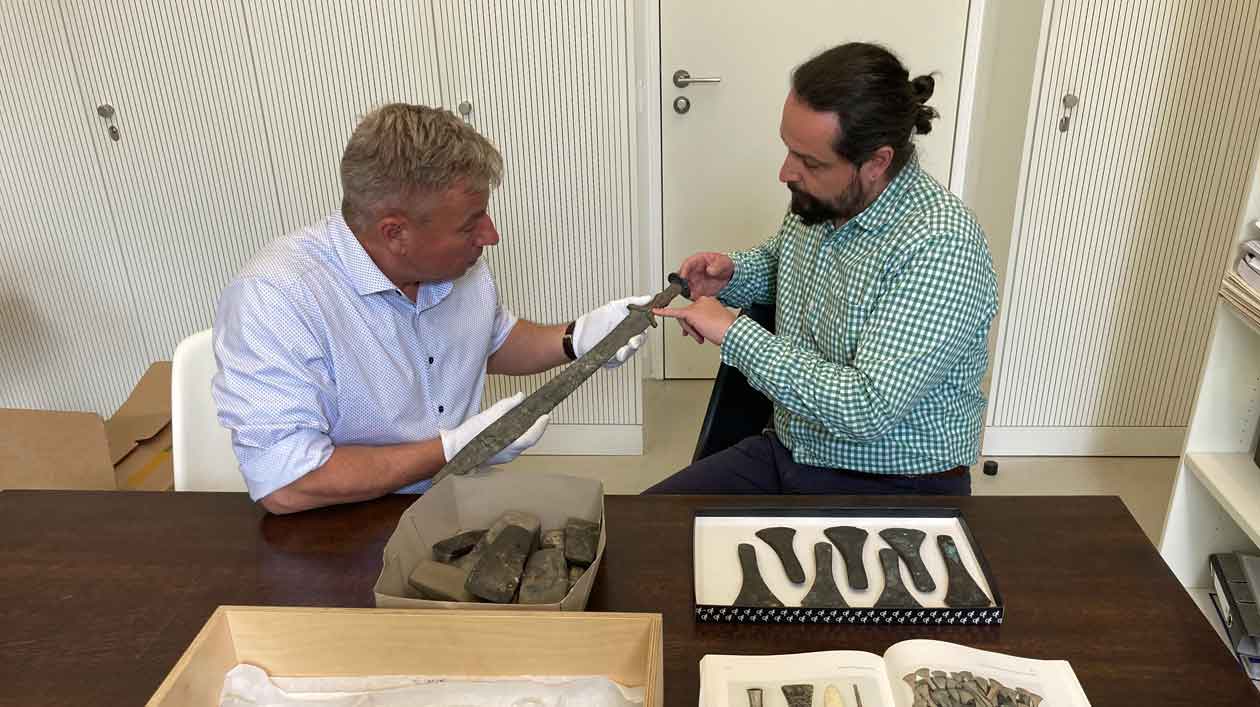Stone Axes and a Bronze Sword — Museum für Vor- und Frühgeschichte Receives More “Finds” from the Ruins of the Former Kunstgewerbemuseum
News from 05/17/2022
Nineteen bronze axes, a bronze sword, and fifteen stone axes have found their way back to the collection of the Museum für Vor- und Frühgeschichte. Some of these artifacts were probably part of the important Bennewitz Hoard.

After the widow of Berlin-based painter Peter Grämer returned objects to the Museum für Vor- und Frühgeschichte (Museum of Prehistory and Early History), the resulting media coverage caught the attention of artist Arndt Maibaum. A few days later, Mr. Maibaum called the office of the museum and asked it to pick up items he had recovered decades earlier in the Martin-Gropius-Bau. The items were neatly packed up in cardboard boxes and presented to Bernhard Heeb, a curator at the museum. “The sword and some of the Stone Age objects had even been ornaments in the couple's apartment,” Heeb says. “So they were clearly very important to the artist and his family.” The ornamentation of the bronze sword is still clearly visible, despite the burn marks. “The sword is a special piece because of its curved edge,” adds Heeb. “We haven't yet been able to classify it unequivocally, but we will definitely identify it!”
Martin-Gropius-Bau, today a well-known exhibition venue in Berlin, originally housed the collections of the Kunstgewerbemuseum (Museum of Decorative Arts). From 1921 onward, it also held those of the Museum für Vor- und Frühgeschichte (Museum of Prehistory and Early History). In World War II, the museums were only able to save their most valuable objects from destruction. During bombing near the end of the war, tens of thousands of objects from all ages were buried in ash and rubble. It was not until 1970 that the ruins were fully cleared. “We know that in West Berlin, there was essentially a run on the largely unsecured museum ruins, and many people — individually and in groups — dug out objects,” says Matthias Wemhoff, director of the Museum für Vor- und Frühgeschichte. “Given this background, we’re absolutely delighted to be seeing the second return of ‘finds’ within such a short period of time.”
A total of 35 objects are being added to the museum's inventory: 19 bronze axes, 1 bronze sword and 15 stone axes. Although the recovered items no longer bear any accession numbers, some of them are relatively easy to identify. The bronze axes are most likely part of a large hoard found in the town of Bennewitz in the German state of Saxony-Anhalt. The hoard, which constitutes the largest group of Bronze Age artifacts ever recovered, is prominently displayed in the Neues Museum. “We have 164 objects from the Bennewitz hoard, of which 32 were previously missing. Now 19 of those have been recovered,” says Wemhoff. Each individual object in a find of this sort is important, because large numbers of pieces are needed for archaeologists to draw certain inferences about their origins, such as early standardization in the crafting of products.
Of the objects that remained in Martin-Gropius-Bau during the war, thousands are still missing. Quite a few of them are probably still in cellars or lofts in Berlin. “The examples set by Peter Grämer, his widow Christine Weber and Arndt Maibaum are in our view worthy of emulation, and we want to encourage anyone in possession of items that may come from the Gropius building to return them,” says Wemhoff. “You needn't fear any legal consequences – all that awaits you is our sincere gratitude.”
If you or someone you know has objects of this sort, you can contact the museum anytime via E-Mail.

